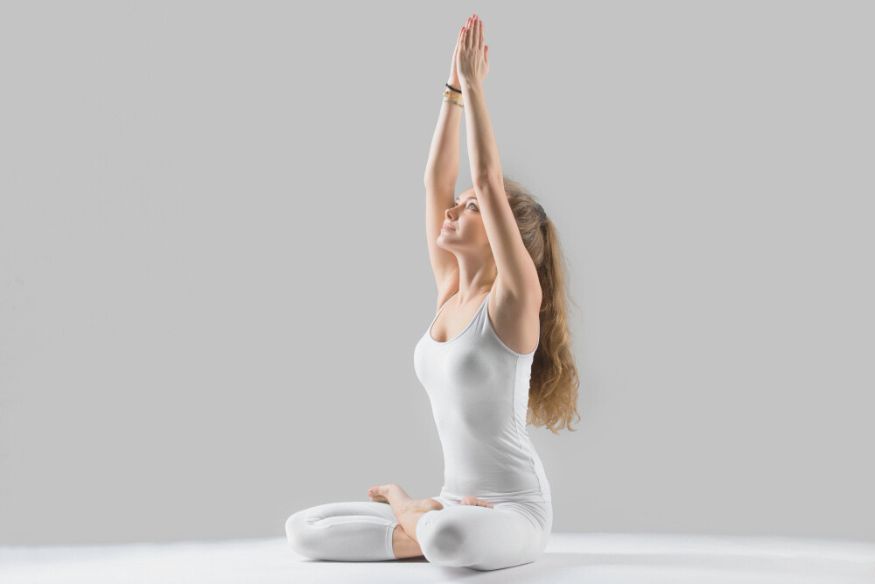Trampoline yoga is a fun and innovative way to take your yoga practice to the next level. Combining the benefits of trampolining with the meditative and mindful practice of yoga, trampoline yoga provides a unique full-body workout that can help increase cardiovascular health, improve balance and coordination, and reduce stress.
Trampoline yoga allows individuals to experience the benefits of yoga poses with the added challenge of balancing and moving on a trampoline surface. Moreover, the trampoline surface provides a low-impact option for individuals with joint issues, making yoga accessible to a wider range of people.
While trampoline yoga may not be for everyone, it’s an excellent option for those who want to add some excitement and challenge to their yoga practice. With proper technique and safety precautions, trampoline yoga can be a fun and effective way to take your yoga practice to new heights.
Introduction to Trampoline Yoga
Trampoline yoga, also known as rebounding, is a form of yoga that is practiced on a mini trampoline. It combines the benefits of yoga with the cardio and strength training of rebounding. Trampoline yoga is a low-impact activity, making it an excellent option for people with joint pain or injuries. It is also a fun and exciting way to add some variety to your yoga practice.

Benefits of Trampoline Yoga
Trampoline yoga is a unique and exciting form of exercise that has gained popularity in recent years. It combines the fun and energetic movements of trampolining with the mindful practice of yoga. In this article, we’ll explore the numerous benefits of trampoline yoga and why it’s worth incorporating into your fitness routine.
Low-Impact Exercise
Trampoline yoga is a low-impact exercise that puts less stress on your joints compared to high-impact exercises like running or jumping. This makes it an ideal workout for people with joint problems, arthritis, or mobility issues. Trampoline yoga is gentle on your joints and minimizes the impact on your spine, making it a safer and more comfortable option for those with physical limitations.
Cardiovascular Health
Trampoline yoga is an excellent cardiovascular workout that can increase your heart rate and improve your blood circulation. This helps to reduce the risk of heart disease, stroke, and other cardiovascular problems. Trampoline yoga is a fun and engaging alternative to traditional cardio exercises like running or cycling, making it easier to maintain a regular workout routine.
Balance and Coordination
Trampoline yoga challenges your body’s sense of balance and coordination, which can improve your spatial awareness and overall stability. This form of exercise requires you to stay balanced on a bouncy surface, activating the muscles in your core, legs, and hips. As you practice trampoline yoga, you’ll notice an improvement in your balance and coordination, which can translate to other areas of your life, such as sports or daily activities.
Muscle Strength
Trampoline yoga strengthens your muscles, particularly in your legs, core, and back. This is because it requires you to engage your muscles to maintain your balance and perform various poses. Over time, trampoline yoga can help you develop lean muscle mass and improve your overall strength. It’s a great way to tone and sculpt your body while having fun.
Reduces Stress and Anxiety
Trampoline yoga is a fun and relaxing form of exercise that can help reduce stress and anxiety. The bouncing motion of the trampoline and the deep breathing of yoga help to stimulate the production of endorphins, which are the body’s natural feel-good hormones. This can leave you feeling more relaxed, calm, and centered after your workout.
How to Use a Trampoline for Yoga Practice?
Before you begin practicing trampoline yoga, learning how to use it properly is essential. Start by standing on the trampoline with your feet hip-width apart and your arms by your sides. Bounce gently up and down, always keeping your feet on the trampoline. Once you are comfortable with the bouncing motion, you can start to incorporate yoga poses.
When practicing trampoline yoga, focusing on your breath and moving slowly and mindfully is crucial. The bouncing motion of the trampoline can be disorienting at first, so take your time and be patient with yourself. Remember always to keep your feet on the trampoline and avoid any sudden or jerky movements.
Safety Tips for Trampoline Yoga
Trampoline yoga is a fun and challenging exercise that combines the benefits of trampolining with the mindful practice of yoga. However, it’s important to remember that trampoline yoga can also pose some risks if not practiced safely. In this article, we’ll explore some essential safety tips to keep in mind when practicing trampoline yoga.
Choose a safe and sturdy trampoline
When practicing trampoline yoga, choosing a safe and sturdy trampoline is significant. Make sure the trampoline has a sturdy frame, secure springs, and a strong jumping surface. Also, ensure that the trampoline is designed for yoga practice and not just for recreational jumping. A trampoline with a safety enclosure is also recommended.
Wear proper attire
Wearing the proper attire can help prevent injuries during trampoline yoga. Wear comfortable and breathable clothing that allows you to move freely but not too loose that it could get caught on the trampoline. Avoid wearing jewelry or anything with sharp edges that could scratch the trampoline’s surface or hurt you during your practice. Non-slip socks or shoes are also recommended to prevent slipping on the surface.
Warm-up and stretch
It’s vital to warm up and stretch before starting your trampoline yoga practice. This can help prevent muscle strain or injury. Start with some light cardio exercises to get your blood flowing, and then perform some yoga poses to stretch and prepare your muscles for the trampoline.
Use proper form and technique
Using proper form and technique during trampoline yoga is crucial for your safety. This means maintaining proper posture, engaging your core muscles, and landing softly on the trampoline surface. Avoid bouncing too high or doing movements that could pressure your joints or spine excessively.
Practice with a partner or instructor
Practicing trampoline yoga with a partner or instructor can be beneficial for safety reasons. They can help guide you through the practice, correct your form, and assist you if you need help getting in or out of a pose. It’s also a good idea to have someone nearby in case of an emergency.
Trampoline Yoga Poses for Beginners
If you are new to trampoline yoga, start with some basic poses to get comfortable with the bouncing motion of the trampoline. Begin by standing on the trampoline with your feet hip-width apart and your arms by your sides. Bounce gently up and down, focusing on your breath.
From here, you can move into some basic yoga poses, such as downward dog or warrior I. These poses can be modified to incorporate the bouncing motion of the trampoline. For example, in downward dog, you can bounce your knees up to your chest on the inhale and extend your legs back on the exhale.
Advanced Trampoline Yoga Poses
Once you are comfortable with the basic poses, you can start to incorporate more advanced trampoline yoga poses. These poses require more balance and stability and can be challenging but also fun and rewarding. Some advanced trampoline yoga poses include handstand, scorpion, and flying squirrel.
Remember always to practice safely and use proper alignment when attempting advanced poses. It is also essential to warm up properly and work your way up to more challenging poses gradually.
Trampoline Yoga vs. Traditional Yoga
Trampoline yoga offers a unique twist on traditional yoga practice. While traditional yoga focuses on stillness and mindfulness, trampoline yoga adds an element of fun and excitement. Trampoline yoga also offers the benefits of rebounding, including improved cardiovascular health and increased strength and flexibility.
However, trampoline yoga may only be appropriate for some. Traditional yoga may be a better option if you have joint pain or injuries. Additionally, some people may find the bouncing motion of the trampoline disorienting or uncomfortable.
Setting Up Your Trampoline Yoga Space
When practicing trampoline yoga at home, it is important to have a dedicated space for your trampoline. Choose a clutter-free space with enough room to bounce on the trampoline safely. You may also want to invest in a yoga mat underneath the trampoline for added support and cushioning.
Trampoline Yoga Accessories You Need
To enhance your trampoline yoga practice, there are several accessories you may want to consider. A stability bar can be helpful for beginners or anyone who needs extra support. An ankle weight set can add resistance and help build strength, while a rebounder cover can protect your trampoline from wear and tear.
Tips for Practicing Trampoline Yoga at Home
When practicing trampoline yoga at home, it is crucial to create a routine and stick to it. Set aside a specific time each day for your practice and make sure you have a dedicated space for your trampoline. Finding a trampoline yoga class or online tutorial to guide your practice can also be helpful.
How to Choose the Right Trampoline for Yoga Practice?
When choosing a trampoline for yoga practice, it is essential to look for a high-quality trampoline that is designed for exercise. Look for a trampoline with a weight limit that can accommodate your body weight and choose a size that fits your space and needs. You may also want to consider additional features, such as a stability bar or rebounder cover.
Yoga On Trampoline
Conclusion
Trampoline yoga is a unique and innovative way to incorporate the benefits of trampolining into your yoga practice. It provides a challenging and fun workout that can improve balance, coordination, and cardiovascular health while reducing stress.
While trampoline yoga may not be suitable for everyone, it is an excellent option for those looking to add variety and excitement to their yoga practice. As with any form of exercise, it’s essential to start slowly, wear appropriate footwear, and use a trampoline with safety features such as a net enclosure and padded frame.
Practicing under the guidance of a qualified instructor who can help ensure proper technique and form is also recommended. With the right precautions and guidance, trampoline yoga can be a safe and effective way to take your yoga practice to new heights. So, if you’re looking for a new and exciting way to challenge your mind and body, consider incorporating trampoline yoga into your fitness routine.
Frequently Asked Question
Is trampoline yoga suitable for beginners?
Trampoline yoga can be suitable for beginners with proper guidance and safety precautions. It’s recommended to start with basic poses and gradually increase difficulty under the guidance of a qualified instructor.
What safety precautions should be taken when practicing trampoline yoga?
It’s essential to use a trampoline with safety features such as a net enclosure and padded frame, wear appropriate footwear, and practice under the guidance of a qualified instructor. It’s also important to start slowly and gradually increase difficulty.
What kind of trampoline is best for trampoline yoga?
A mini-trampoline or rebounder with a diameter of 40 inches or less is typically best for trampoline yoga. It should also have safety features such as a net enclosure and padded frame.
Can trampoline yoga be practiced at home?
Trampoline yoga can be practiced at home, but it’s vital to have a suitable trampoline and proper guidance from a qualified instructor. It’s also crucial to ensure a safe practice area and proper ventilation
Last Updated on August 25, 2023

